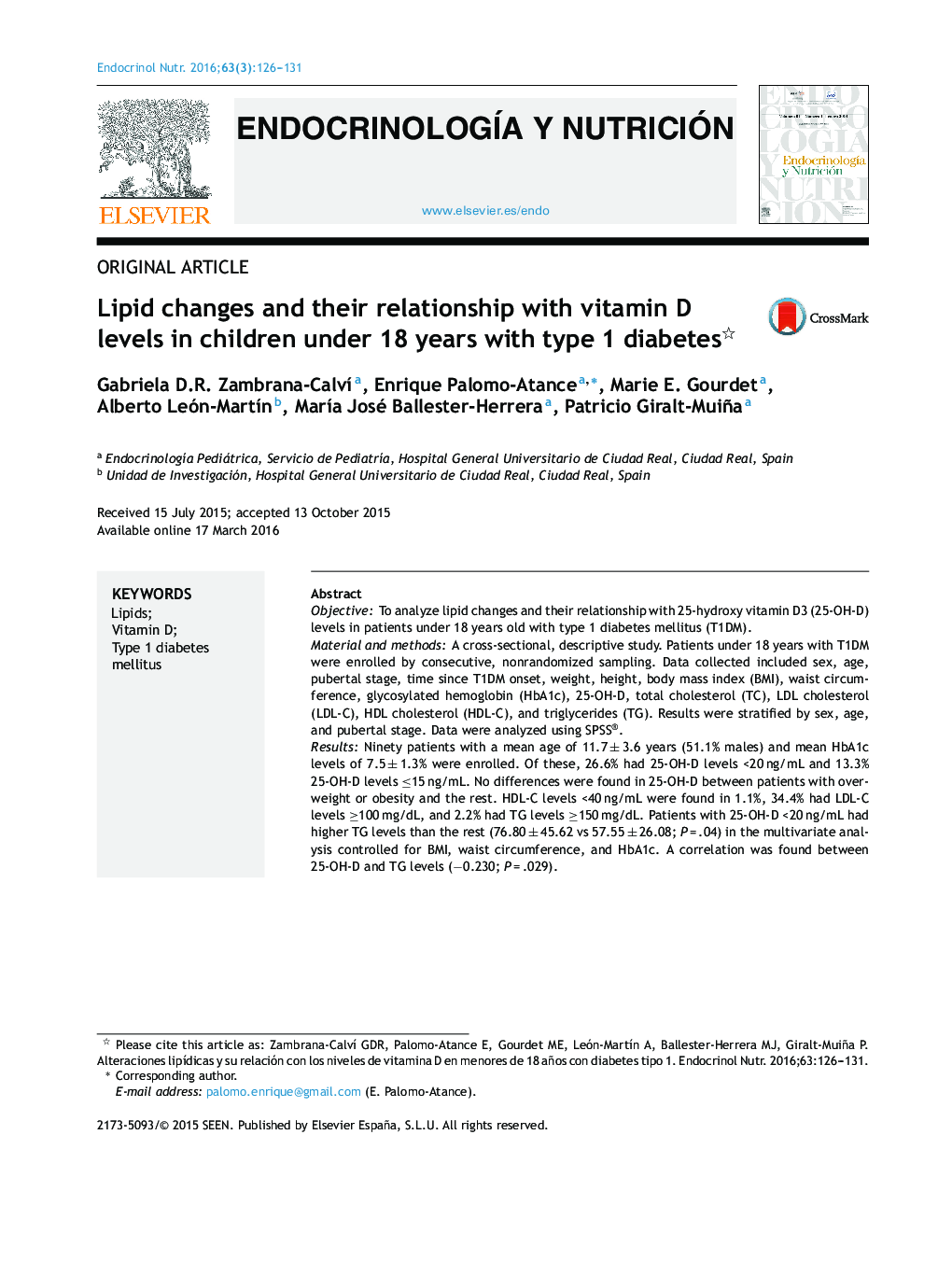| Article ID | Journal | Published Year | Pages | File Type |
|---|---|---|---|---|
| 3266816 | Endocrinología y Nutrición (English Edition) | 2016 | 6 Pages |
ObjectiveTo analyze lipid changes and their relationship with 25-hydroxy vitamin D3 (25-OH-D) levels in patients under 18 years old with type 1 diabetes mellitus (T1DM).Material and methodsA cross-sectional, descriptive study. Patients under 18 years with T1DM were enrolled by consecutive, nonrandomized sampling. Data collected included sex, age, pubertal stage, time since T1DM onset, weight, height, body mass index (BMI), waist circumference, glycosylated hemoglobin (HbA1c), 25-OH-D, total cholesterol (TC), LDL cholesterol (LDL-C), HDL cholesterol (HDL-C), and triglycerides (TG). Results were stratified by sex, age, and pubertal stage. Data were analyzed using SPSS®.ResultsNinety patients with a mean age of 11.7 ± 3.6 years (51.1% males) and mean HbA1c levels of 7.5 ± 1.3% were enrolled. Of these, 26.6% had 25-OH-D levels <20 ng/mL and 13.3% 25-OH-D levels ≤15 ng/mL. No differences were found in 25-OH-D between patients with overweight or obesity and the rest. HDL-C levels <40 ng/mL were found in 1.1%, 34.4% had LDL-C levels ≥100 mg/dL, and 2.2% had TG levels ≥150 mg/dL. Patients with 25-OH-D <20 ng/mL had higher TG levels than the rest (76.80 ± 45.62 vs 57.55 ± 26.08; P = .04) in the multivariate analysis controlled for BMI, waist circumference, and HbA1c. A correlation was found between 25-OH-D and TG levels (−0.230; P = .029).ConclusionsPatients in our population with vitamin D deficiency had higher TG levels. Long-term follow-up should be performed to understand the potential impact of such levels on diabetes-related complications.
ResumenObjetivoAnalizar en menores de 18 años con diabetes mellitus tipo 1 (DM1) las alteraciones lipídicas y su relación con los niveles de 25 hidroxi vitamina D3 (25-OH-D).Material y métodosEstudio transversal y descriptivo. Se incluyen menores de 18 años con DM1 mediante un muestreo no aleatorizado consecutivo. Determinaciones: sexo, edad, estadio puberal, tiempo de evolución de la DM1, peso, talla, índice de masa corporal, perímetro abdominal, hemoglobina glucosilada (HbA1c) 25-OH-D, colesterol total, LDL-colesterol, HDL-colesterol y triglicéridos (TG). Se estratifican los resultados para sexo, edad y estadio puberal. Se analizan los datos con el programa SPSS®.ResultadosSe recogen 90 pacientes: edad media de 11,7 ± 3,6 años, predominio masculino (51,1%) y HbA1c media de 7,5 ± 1,3%. El 26,6% presentan 25-OH-D < 20 ng/ml y el 13,3% 25-OH-D ≤ 15 ng/ml. No se observan diferencias en la 25-OH-D en pacientes con sobrepeso-obesidad respecto al resto. El 1,1% presentan HDL-colesterol < 40 ng/ml, el 34,4% LDL-colesterol ≥ 100 mg/dl y el 2,2% TG ≥ 150 mg/dl. Los pacientes con 25-OH-D < 20 ng/ml presentan valores superiores de TG que el resto (76,80 ± 45,62 vs 57,55 ± 26,08; p = 0,04) en el análisis multivariante para índice de masa corporal, perímetro abdominal y HbA1c. Se observa correlación entre los niveles de 25-OH-D y los TG (−0,230; p = 0,029).ConclusiónEn nuestra población los pacientes con insuficiencia de vitamina D muestran valores de TG superiores. Debe realizarse un seguimiento a largo plazo para conocer las repercusiones sobre las complicaciones relacionadas con la diabetes.
